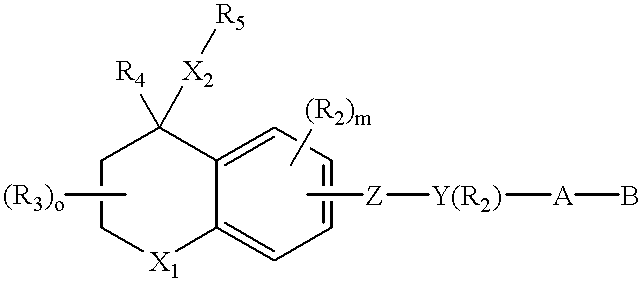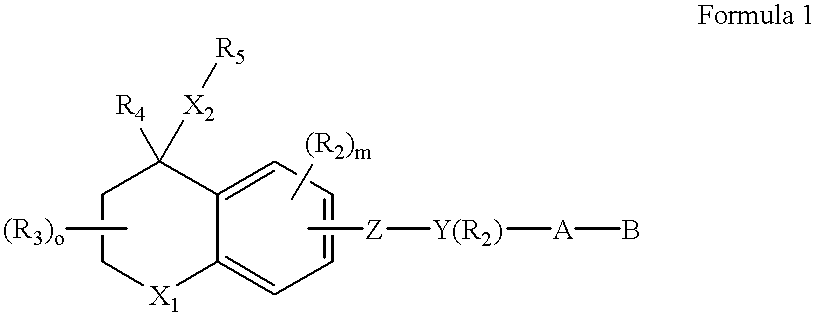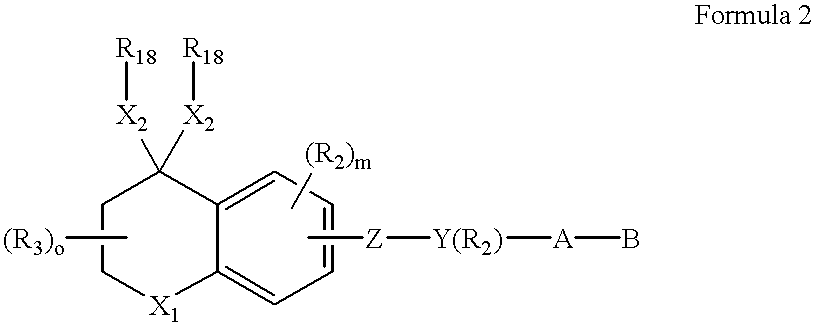O- or S- substituted tetrahydronaphthalene derivatives having retinoid and/or retinoid antagonist-like biological activity
a technology of retinoid antagonists and tetrahydronaphthalene, which is applied in the field of substituted tetrahydronaphthalene derivatives with retinoid and/or retinoid antagonistlike biological activity, can solve the problems of limiting the acceptability and utility of retinoids for treating diseases, and the number of undesired side effects, so as to eliminate or reduce the side effects of retinoids
- Summary
- Abstract
- Description
- Claims
- Application Information
AI Technical Summary
Benefits of technology
Problems solved by technology
Method used
Image
Examples
specific embodiments
With reference to the symbol Y in Formulas 1 through 6, the preferred compounds of the invention are those where Y is phenyl, naphthyl, pyridyl, thienyl or furyl. Even more preferred are compounds where Y is phenyl, naphthyl or pyridyl. As far as substititutions on the Y (phenyl), Y (pyridyl) and (Y) naphthyl groups are concerned, compounds are preferred where the phenyl group is 1,4 (para) substituted, the naphthyl group is 2,6 substituted and where the pyridine ring is 2,5 substituted. (Substitution in the 2,5 positions in the "pyridine" nomenclature corresponds to substitution in the 6-position in the "nicotinic acid" nomenclature.) In the preferred compounds of the invention there is no optional R.sub.2 substituent on the Y group.
The A--B group of the preferred compounds is (CH.sub.2).sub.n --COOH or (CH.sub.2).sub.n --COOR.sub.8, where R.sub.8 is defined as above. Even more preferably n is zero and R.sub.8 is lower alkyl.
Referring still to the preferred compounds of Formulas 1 ...
specific examples
Ethyl (4-bromophenyl)acetate (Compound A)
A solution of 43 g (200 mmol) of 4-bromophenylacetic acid and 0.2 g of conc. H.sub.2 SO.sub.4 in 470 ml of ethanol was refluxed for 16 hours. The reaction mixture was cooled to ambient temperature, stirred with 6 g of solid K2CO.sub.3 for 30 minutes and then filtered. The filtrate was concentrated in vacuo. diluted with Et.sub.2 O (200 ml), washed with 10% aqueous NaHCO.sub.3 (10 ml) and brine (10 ml), dried over MgSO.sub.4 and concentrated in vacuo to give the title compound as a colorless oil.
PMR (CDCl.sub.3): .delta. 1.25 (3H, t, J=7.0 Hz), 3.56 (2H, s), 4.15 (2H, q, J=7.0 Hz), 7.16 (2H, d, J=8.4 Hz), 7.45 (2H, d, J=8.4 Hz).
Ethyl (3-bromophenyl)acetate (Compound B)
Employing the same general procedure as for the preparation of ethyl (4-bromophenyl)acetate (Compound A), 100 g (463 mmol) of 3-bromophenylacetic acid was converted into the title compound (yellow oil) using 2 g of conc. H.sub.2 SO.sub.4 and 500 ml of ethanol.
PMR (CDCl.sub.3): .d...
PUM
 Login to View More
Login to View More Abstract
Description
Claims
Application Information
 Login to View More
Login to View More - R&D
- Intellectual Property
- Life Sciences
- Materials
- Tech Scout
- Unparalleled Data Quality
- Higher Quality Content
- 60% Fewer Hallucinations
Browse by: Latest US Patents, China's latest patents, Technical Efficacy Thesaurus, Application Domain, Technology Topic, Popular Technical Reports.
© 2025 PatSnap. All rights reserved.Legal|Privacy policy|Modern Slavery Act Transparency Statement|Sitemap|About US| Contact US: help@patsnap.com



